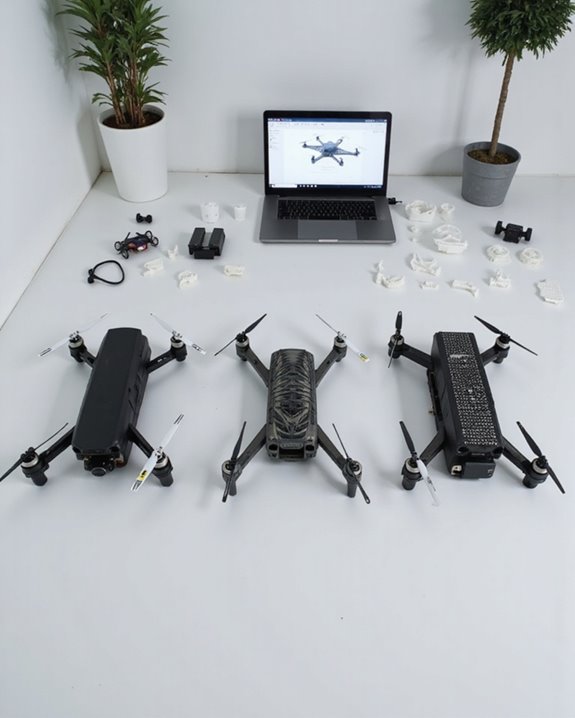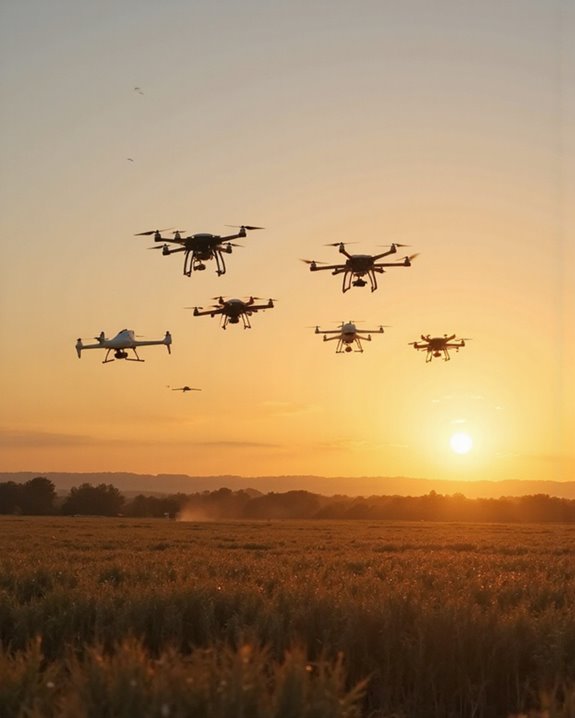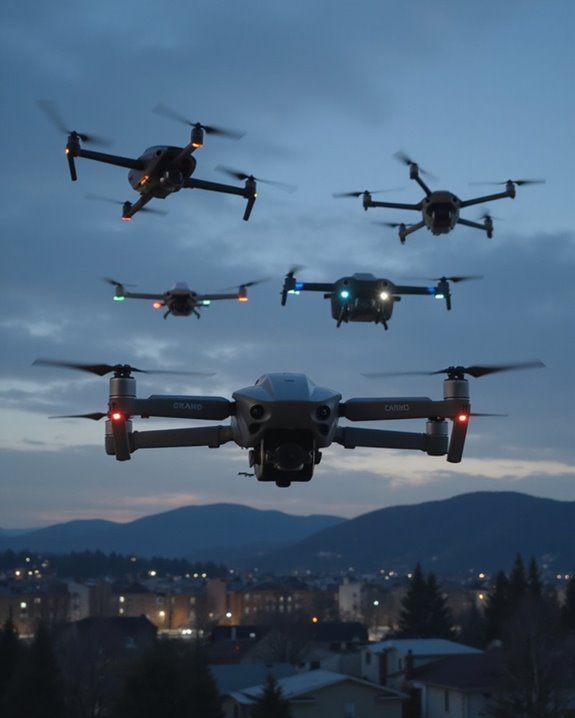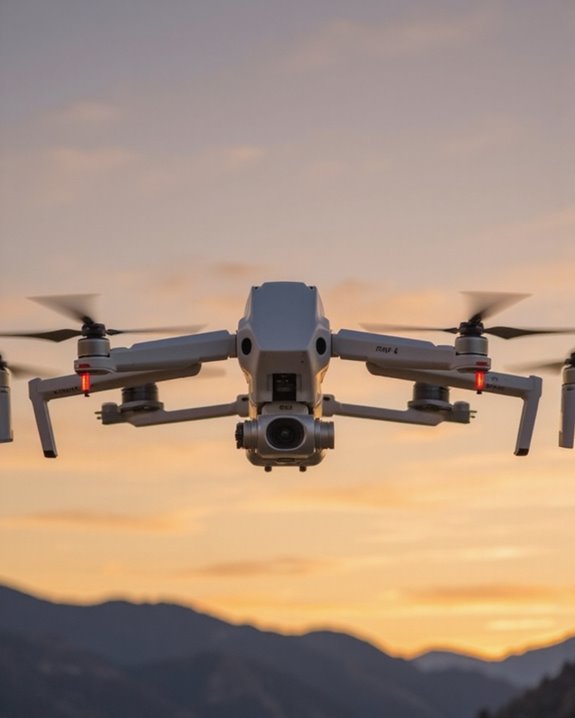The 2025 drone market is exploding with incredible 3D-printed options! You’ll love Pallton’s X80 with its pocket-sized foldability and 24-minute flight time, or BLINORY’s X60 featuring a quieter brushless motor. The N11 PRO GPS stands out with an impressive 90-minute flight time and 4K camera, while Oddire’s X-28 offers trajectory flight capabilities. Don’t overlook Hiturbo’s S20, perfect for beginners at just 146 grams. Proper weight distribution can boost your flight times by 20%!
Key Takeaways
- The Pallton X80 foldable mini drone weighs under 249 grams with dual battery capacity offering 31 minutes per battery.
- BLINORY’s X60 features a 2K HD camera with 90° adjustment and brushless motor for 32 minutes of quieter flight.
- The N11 PRO GPS offers 90-minute total flight time with three batteries and 4K UHD camera capabilities.
- 3D printed drones require proper weight distribution to achieve 20% longer flight times and improved stability.
- Modern 3D printed designs prioritize tensile strength of 30-50 MPa and high impact resistance for durability.
Foldable Mini Drone with 1080P HD Camera for Beginners
- 【Drone with 1080P Camera - Capture Every Wonderful Moment】This drone with camera features a 1080P HD and 90° adjustable camera that captures clear photos. This FPV...
- 【Beginner-Friendly - Simple and Easy to Fly】Designed for beginners, kids, this mini drone simplifies flight with one-button takeoff/landing and altitude hold for...
- 【Long Flight Time - Enjoy Flying Fun】Comes with 2 batteries, letting you enjoy up to 24 minutes of flight time. This foldable drone features a compact, lightweight...
The perfect companion for aspiring aerial photographers, Pallton’s X80 foldable mini drone delivers impressive capabilities in a pocket-sized package! You’ll capture stunning 1080P HD footage with the 90° adjustable lens, perfect for sharing those epic adventure moments on social media. The drone’s intuitive gesture controls let you snap photos with a simple V-sign or start recording with an open palm — no complicated button sequences needed!
With 24 minutes of flight time from two batteries and beginner-friendly features like one-key takeoff and altitude hold, you’ll be performing 360° flips in no time. Its compact design slips easily into the included carrying case, making it your ideal travel buddy for camping trips or backyard flying sessions!
Best For: Beginners, families, and travel enthusiasts seeking an affordable, portable drone with good image quality and user-friendly controls to capture memories during outdoor adventures.
Pros:
- Impressive 24-minute total flight time with two included batteries, giving beginners plenty of practice time without constant recharging
- Compact, foldable design with included carrying case makes it extremely portable for travel and outdoor activities
- Beginner-friendly features like one-key takeoff/landing, altitude hold, and propeller guards reduce the learning curve for first-time drone pilots
Cons:
- Limited range of 100 meters and maximum altitude of 20 meters may restrict more ambitious filming opportunities
- Camera quality, while HD, may not satisfy serious photographers looking for professional-grade aerial imagery
- Lightweight design could make it vulnerable to wind conditions, potentially limiting outdoor usability on breezy days
Mini Drone with Camera, 1080P HD Foldable Drone
- Multiple Functions Drone: Based on the newest upgraded chip than others, our drone has multiple interesting functions. Such as trajectory flight, gravity control, 3D...
- 1080P FPV & Electric Adjustable Camera: This Oddire drone equips an HD 1080P camera, which assists you in catching every wonderful moment from a birds-eye perspective....
- Stable Hover & User Friendly: Equipped with an Optical Flow Positioning Camera, the drone has a more stable hover altitude ability, just calibrate it before takeoff (Turn...
Hobbyists seeking an affordable entry into aerial photography will find Oddire’s X-28 Mini Drone hits the sweet spot between functionality and price! You’ll enjoy impressive features like trajectory flight, gravity control, and a 90° adjustable 1080P HD camera that delivers crystal-clear footage directly to your smartphone.
With two rechargeable batteries providing up to 28 minutes of flight time, you won’t be grounded just as the fun begins. The optical flow positioning system keeps your drone stable even when your piloting skills aren’t! Perfect for beginners ages 14+, the one-key takeoff/landing and altitude hold features mean you’ll be capturing share-worthy aerial shots before you can say “propeller”!
Best For: Beginner drone enthusiasts ages 14+ looking for an affordable entry-level camera drone with user-friendly features and decent flight time.
Pros:
- Impressive feature set including trajectory flight, gravity control, and 90° adjustable 1080P HD camera for the price point
- Extended flight time of up to 28 minutes with the two included rechargeable batteries
- User-friendly operation with one-key takeoff/landing, optical flow positioning for stability, and three adjustable speeds
Cons:
- Limited range of up to 80 meters restricts long-distance exploration
- Wind sensitivity makes outdoor flying challenging in anything beyond light breezes
- 90-minute battery charging time means significant downtime between extended flying sessions
2K HD FPV Drone with Camera for Kids and Beginners
- 【2K HD Camera & 5G Real-time Transmission 】The 2K drone is equipped with a 90° electrically adjustable camera, enabling effortless adjustment of the camera angle for...
- 【Long Flight Time & Brushless Drone】The mini drone is equipped with two modular batteries, providing an 32 minutes of super long flight time. It makes you enjoy...
- 【Beginner-Friendly】 With features such as one-button take off/landing, headless mode, and two speed-switching functions make it easy for kids, beginners or newbies to...
Aspiring young pilots and drone newcomers will find their perfect aerial companion in BLINORY’s X60 model, a standout 2K HD FPV drone that combines impressive features with user-friendly operation. You’ll enjoy crystal-clear footage through its 90° adjustable camera with shock absorption, while the 5GHz transmission guarantees you’re seeing smooth real-time video of your adventures!
The X60’s impressive 32-minute flight time from two modular batteries means more fun, less waiting. Its brushless motor delivers quieter, faster flights—perfect for capturing those backyard stunts. With features like one-key takeoff, headless mode, and weighing under 250g (no FAA registration needed!), you’ll be performing 3D flips in no time.
Best For: Families with children, first-time drone users, and photography enthusiasts looking for an affordable, feature-rich drone that offers extended flight times without requiring FAA registration.
Pros:
- Long 32-minute flight time with two modular batteries allows for extended flying sessions without frequent recharging
- User-friendly features including one-key takeoff/landing, headless mode, and optical flow hover make it accessible for complete beginners
- High-quality 2K HD camera with shock absorption and adjustable angle captures clear, stable footage for impressive aerial photos and videos
Cons:
- The 5GHz Wi-Fi transmission may have limited range compared to more professional drone models
- Plastic construction, while lightweight, might be less durable against crashes than premium drones
- Despite featuring a brushless motor, its performance might still be affected by moderate to strong winds due to its lightweight design
Foldable Drone with 1080P Camera for Beginners (Includes 2 Batteries)
- Drone with 1080P Camera: A camera mounted on it can be manually adjusted to see what's in front of the drone while it's flying, or it can be aimed down to see what's...
- Play Longer: The FPV drone has two rechargeable batteries, each providing approximately 12 minutes of flight time. 2 batteries can be swapped & charged in rotation,...
- Remote Control & App: You can fly the mini drone with remote control or a smart phone. But in order to capture video or images, you must be connected to the drone via...
Perfect for newcomers stepping into the exciting world of aerial photography, Hiturbo’s S20 foldable quadcopter combines simplicity with impressive functionality. You’ll enjoy 24 minutes of total flight time thanks to the two included batteries, giving you plenty of opportunities to perfect those aerial selfies and 3D flips!
Control options are versatile—use either the remote control or your smartphone via the Hiturbo FPV app. The adjustable 1080P camera can point forward or downward, making it ideal for roof inspections or capturing friends skating below. At just 146 grams, it’s lightweight enough for kids but sophisticated enough for adults. One minor drawback: some users report shorter-than-advertised battery life.
Best For: Beginners, kids, and adults who want an affordable and easy-to-use drone with basic camera capabilities for casual aerial photography and fun flying experiences.
Pros:
- Includes two batteries providing up to 24 minutes of total flight time
- Features multiple control options including remote, smartphone app, and gesture control
- Lightweight (146g) foldable design with one-key start makes it extremely portable and beginner-friendly
Cons:
- Actual battery life may be significantly shorter than the advertised 12 minutes per battery
- Camera quality is lower than advertised with some users reporting poor pixel resolution
- Limited range (0.05km maximum) and stability issues in windy conditions
N11 PRO GPS Drone with 4K UHD Camera (90 Min Flight Time)
- 【Under 0.55lb Mid-sized Drone, No FAA Registration】Designed with a unique material composition, the N11 PRO is a remarkably valuable mid-sized GPS drone (not mini...
- 【Brushless Motors & Long Flight Time and Control Range】Enduring alloy brushless motors feature strong wind resistance and provides a faster, quieter while more...
- 【Dual Positioning System】Optical Flow Positioning provides you a safer indoor flight while GPS Positioning gives a more free and stabilized outdoor flight. They also...
The N11 PRO GPS Drone delivers exceptional flight time for travelers and outdoor enthusiasts who don’t want their adventures cut short by a dying battery. With three batteries providing a whopping 90 minutes of airtime, you’ll capture twice the footage of standard drones!
You’ll love the crystal-clear 4K UHD camera that snaps 4096×3072 photos and smooth 2048×1080 videos through its adjustable wide-angle lens. The drone’s dual positioning system switches seamlessly between indoor optical flow and outdoor GPS, meaning you’ll never lose control of your aerial companion. At under 0.55lb, you won’t need FAA registration—just unfold, launch, and let the intelligent GPS features like Follow Me and Point of Interest do the work!
Best For: Travel photographers, outdoor enthusiasts, and content creators seeking extended flight time with high-quality aerial footage capabilities in a portable, registration-free drone package.
Pros:
- Impressive 90-minute total flight time with three batteries allows for extended shooting sessions without frequent interruptions
- Lightweight design under 0.55lb means no FAA registration required, while the foldable structure and carrying case enhance portability
- Advanced features like dual positioning system, 4K UHD camera, and intelligent GPS functions (Follow Me, Tap Fly) provide professional-grade capabilities
Cons:
- Total flight time requires swapping between three batteries rather than a single extended-life power source
- 2048×1080 video resolution, while HD, falls short of true 4K video quality despite the camera being marketed as 4K UHD
- Limited output power of 2mW may restrict performance in challenging weather conditions despite wind resistance claims
Factors to Consider When Choosing a 3D Printed Drone

When you’re picking a 3D printed drone, you’ll need to weigh several critical factors that directly impact performance and longevity. Your choice of materials matters tremendously, as PLA might be easier to print but ABS and PETG offer the durability needed for those inevitable crash landings! Beyond materials, you’ll want to evaluate design complexity, weight distribution, and assembly requirements to make sure your custom drone doesn’t just look amazing but actually stays airborne.
7 Subheading Discussion Points
Selecting your ideal 3D printed drone involves weighing several essential factors that can make or break your flying experience. First, prioritize flight duration—with today’s models offering anywhere from 24 to 90 minutes with multiple batteries, you’ll want enough airtime for your adventures!
Camera quality should be next on your checklist; 4K UHD capabilities can transform ordinary shots into breathtaking aerial masterpieces. Don’t overlook stability features like altitude hold and optical flow positioning, which will save you from the dreaded “first-time crash syndrome”!
Consider weight too—drones under 250 grams often bypass registration requirements, perfect for spontaneous flights. Finally, look for GPS navigation with auto-return functionality. Nothing ruins a day faster than watching your investment disappear over the horizon!
Material Durability
How well your 3D printed drone withstands crashes, bumps, and environmental challenges ultimately determines whether you’ll enjoy months of flying or face hours of repairs! When examining durability, focus on the tensile strength of materials, which typically ranges from 30-50 MPa in quality thermoplastics. This makes all the difference when your drone meets a tree!
Look for models with high impact resistance (10-20 kJ/m² in Izod tests), and don’t overlook infill density—anything above 50% substantially improves compression strength. You’ll also want to evaluate layer adhesion strength (20-40 MPa is ideal) to prevent those dreaded delamination issues during high-stress maneuvers.
For outdoor enthusiasts, UV-resistant materials are non-negotiable, as standard polymers can lose half their strength over time in sunny conditions. Your future self will thank you!
Design Complexity
The intricacy of your drone’s design represents one of the most essential factors in determining both its performance envelope and your sanity levels during the build process! Complex designs often require sophisticated supports and infill patterns that, while visually impressive, can increase your risk of structural failures if not properly managed.
You’ll need to balance your ambitions with practical considerations. More complex designs typically demand finer layer resolutions (0.1mm) for precise details and substantially longer print times—what could be a weekend project might turn into a week-long venture! Additionally, simpler designs typically weigh 20-30% less than their complex counterparts, directly impacting flight efficiency.
Weight Distribution
Proper weight distribution might seem like an afterthought when selecting your 3D printed drone, but it’s actually one of the most essential factors determining whether your creation soars gracefully or performs an impromptu nosedive! You’ll want to make sure the center of gravity sits within 5-10% of the drone’s longitudinal axis, keeping everything balanced and efficient.
Did you know that just a 2-5 gram imbalance can compromise your drone’s stability in windy conditions? That’s barely the weight of a nickel! When examining potential models, look for designs with adjustable infill density options that let you fine-tune weight placement across the frame. Your reward? Up to 20% longer flight times and noticeably smoother video footage. Trust us, you’ll appreciate the difference when your drone isn’t fighting itself mid-flight!
Assembly Requirements
Diving into the assembly process before purchasing your 3D printed drone can save you hours of frustration and potential disappointment! The complexity ranges dramatically between models, with some featuring convenient snap-fit designs while others require meticulous gluing and fastening for proper structural integrity.
You’ll want to inventory the tools needed—do you have the right screwdrivers, adhesives, or pliers on hand? Time commitment varies greatly, from quick 30-minute builds to weekend-long projects that’ll test your patience! Don’t forget about post-assembly calibration, which is essential for stable flight. Many beginners overlook this critical step!
Also consider material requirements, as some designs need additional reinforcements or specific printing tolerances. Trust me, there’s nothing worse than getting halfway through assembly only to realize you’re missing that one essential component!
Component Compatibility
Selecting compatible components for your 3D printed drone isn’t just important—it’s absolutely critical for achieving that perfect maiden flight! You’ll need to make sure your printed parts align precisely with standard motor mounts and propeller hubs to avoid frustrating assembly headaches later.
Don’t overlook material compatibility—your drone’s frame must handle the vibrations from those zippy ESCs and power-hungry batteries. Trust me, there’s nothing worse than watching your creation shake itself apart mid-flight!
Check that electrical connectors on your 3D printed housings match the voltage requirements of your circuits and sensors. Your drone’s weight distribution deserves special attention too, as proper balance between frame and propulsion system is essential for those smooth aerial maneuvers. And remember, your flight control modules need proper interfaces that follow standard protocols like PWM or I2C!
Print Resolution Needs
The unsung hero of any impressive 3D printed drone is certainly the print resolution you choose! When crafting your aerial masterpiece, aim for the sweet spot of 50-100 microns per layer to achieve those crisp, aerodynamic details that’ll make your drone slice through the air like a hot knife through butter.
You’ll want to target 0.1mm (or finer) resolution for critical components like propellers and frames. This precision isn’t just for show—it greatly reduces stress points and improves material bonding, giving you a sturdier flyer that won’t quit mid-mission! While it’s tempting to crank up to 200-300 microns for faster printing, you’ll sacrifice the fine details that keep your drone stable. Remember, anything finer than 50 microns might have you waiting forever with minimal performance gains!
Frequently Asked Questions
What Materials Are Commonly Used for 3D Printing Drones?
You’ll commonly use PLA (polylactic acid) for your drone frames due to its lightweight properties and ease of printing. For more durability, consider PETG or ABS which offer better impact resistance when your drone takes those inevitable tumbles! Nylon filaments provide excellent flexibility for parts that need to absorb vibration, while TPU works wonderfully for shock-absorbing components like landing gear. Carbon fiber-infused filaments are gaining popularity too, giving you that perfect balance of strength and weight reduction!
How Long Does It Take to 3D Print a Complete Drone?
Like Rome, your drone won’t be built in a day! Printing times vary widely depending on complexity and size. You’ll spend about 10-15 hours printing a basic mini drone frame, while a complex full-sized model might take 30-50 hours. The larger components like the body typically require 6-8 hours each, with smaller parts adding additional time. Don’t forget post-processing too—sanding, assembly, and electronics installation will add several more hours to your project!
Can I 3D Print Replacement Parts for Commercial Drones?
Yes, you can absolutely 3D print replacement parts for commercial drones! Many components like propeller guards, landing gear, and camera mounts are perfect candidates for home printing. You’ll need the right filament type—typically PETG or nylon for durability—and accurate measurements of the original part. While complex electronic components aren’t printable, frame pieces and accessories are fair game. Just remember, critical components like propellers require proper balancing, so not everything should be DIY’d for safety reasons!
What Software Is Recommended for Designing 3D Printable Drones?
For designing 3D printable drones, you’ll love working with Fusion 360, which offers powerful parametric modeling perfect for precise drone components! Tinkercad provides a beginner-friendly alternative if you’re just starting out. More specialized options include OpenVSP for aerodynamic analysis, while FreeCAD gives you a robust open-source solution. Don’t forget about Blender, which, although primarily for animation, has fantastic mesh modeling capabilities that drone enthusiasts are increasingly adopting for their creative aerial projects.
Are 3D Printed Drones as Durable as Commercially Manufactured Ones?
3D printed drones have come a million miles in durability, but they’re still not quite as tough as their commercial counterparts. You’ll find they’re more susceptible to impact damage and environmental stress. However, with the right materials like reinforced PETG or carbon-fiber infused filaments, you can create surprisingly resilient aircraft! The trade-off? Your homemade flyer offers customization and repairability that store-bought models can’t match. Just expect to replace parts more frequently during those inevitable crash landings!










